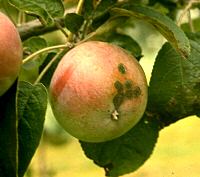|

|
General Instructions
In order for the simulation to run on your computer, your browser must be Java-enabled.
For a free download of the necessary software and the installation instructions, go to
http://www.java.com/en/download/manual.jsp.
Click the Start Simulation
button to the left. The simulation opens in a new window,
across the top of which is a menu bar. Check each menu and note the
selections in each. The menu at the far right is a Help menu
that gives you an explanation of each command and menu selection.
From the Cultivar menu, you can select cultivars with low, moderate,
and high levels of resistance to Venturia, and from the
Environment menu, you can select various weather options to see how
apple scab responds to temperature and moisture. In the Inoculum
menu, you can enter values for the numbers of ascospores released from the dead
leaves on the ground within the orchard or blown into the
orchard from adjacent areas.
The Management menu allows you to monitor the progress
of ascospore maturation, to check the weather forecast,
and to spray a choice of simulated fungicides modeled after real fungicides.
As the simulation proceeds, a popup window appears with a photograph of bud development
at that stage. Each popup window must be closed before the simulation can continue.
The simulation behaves somewhat differently with different browsers and from one
computer to the next. If the model does not load fully on the first try, close it and
open it again. If the scrollbar just below the graph does not appear, increase the
resolution of your monitor and/or enlarge the simulation window. If the help window
will not appear, check to see that the browser's popup blocker is turned off for this application.
For a detailed description of how the simulation works and how the model is
constructed, see the Applescab Model Description .
....proceed to EXERCISE 1
|
Introduction
Apple scab,
caused by the fungus Venturia inaequalis, is also known
by the name "black spot." It occurs everywhere in the world
where apples are grown and causes more losses than any other apple disease. It is most
serious in areas that have cool, wet weather during the spring and may not be
economically important in warm or dry climates.

Apple scab
is without question the most economically important apple disease.
Most of the loss results from blemished fruit at harvest. Such fruit not only loses its
fresh market appeal, but because the cuticle is ruptured, infected apples also dry and shrivel rapidly in storage.
On apples for processing, small, superficial lesions can readily be peeled off. Apples with severe
infections are sold at a lower grade for cider. If a given run of apples has even a small amount of
apple scab, additional personnel are needed to sort the fruit, whether it be for processing or fresh
market. To offset these additional handling costs, the prices paid to growers are reduced
accordingly.
|
|
Arneson, P. A. 2005. Management of Applescab: Simulation with Applescab. The Plant Health Instructor. DOI:10.1094/PHI/A-2005-0722-02.
The original Applescab simulation was written in 1977
in Fortran for mainframe computers
by Phil A. Arneson, Timothy R. Oren, Rosemary Loria, Jeffrey J. Jenkins,
Erik D. Goodman, and William E. Cooper at Michigan State University.
It was rewritten into Java and modified as a web application in 2002
by Joshua M. Goldfarb and Phil A. Arneson.
We have retained the original structure of the model
wherever possible, but some small modifications have been necessary to
enhance its pedagogical value. While the simulation is sufficiently
realistic for teaching purposes, it should not be trusted as a
research tool or a management decision making aid.
|
|